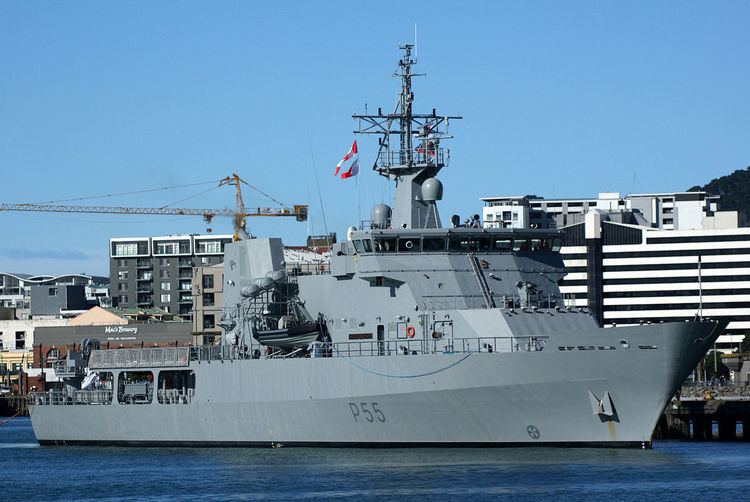Builders Tenix, Williamstown Preceded by N/A | Succeeded by N/A | |
 | ||
Cost $110 million per vessel | ||
The Protector-class offshore patrol vessel (also known as the Otago-class) is a ship class of two offshore patrol vessel (OPVs) operated by the Royal New Zealand Navy (RNZN) since 2010. The ships are named HMNZS Otago and HMNZS Wellington.
Contents
Key dates
The Ministry of Defence issued invitations to register in July 2002 and signed a contract with Tenix Defence (later BAE Systems) in July 2004. The first steel was cut in February 2005 and the first OPV HMNZS Otago was launched on 18 November 2006 in Melbourne, Victoria.
The original planned delivery date for HMNZS Otago was April 2007, this was then revised to early 2008. HMNZS Wellington was launched on 27 October 2007 with an original delivery date of May / June 2008.
While the ships are capable of carrying the SH-2G Seasprite on 30 October 2007 the NZDF announced the acquisition by NZDF of A109 light utility helicopter for training and deployment on RNZN ships including OPVs.
In September 2008 the Minister of Defence announced delays in delivery of the two OPVs due to questions regarding the ships' seaboats and Lloyds Certification. He says the issue is under negotiation with BAE (ex-Tenix). In May 2009, mediation between the Ministry of Defence and BAE Systems commenced, with the main issue being the estimated 300 tonnes increase in weight which could cause potential hazard when OPVs are in ice in Antarctica as the weight increased over the life of the vessels.
On the 18 February 2010 Otago was accepted into the Royal New Zealand Navy. NZ Ministry of Defence claims overweight issue not as bad as previously thought, but "weight will have to be carefully monitored during the ship's life". Should arrive at Devonport (Auckland) Naval Base 26 March 2010. Wellington was accepted on 6 May 2010 and arrived at Devonport later that month. HMNZS Otago arrived at Devonport Naval Base after further delay in Australia due to engine problems, now fixed under warranty.
Design origin
Conceived as part of Project Protector, the Ministry of Defence project consisted of acquiring one multi-role vessel, two offshore and four inshore patrol vessels. The Project Protector vessels will be operated by the RNZN to conduct tasks for and with the New Zealand Customs Service, the Department of Conservation, Ministry of Foreign Affairs and Trade, Ministry of Fisheries, Maritime New Zealand, and New Zealand Police. The Government and Navy policy was the OPVs are intended to carry out resource protection functions in the EEZ, Sth Pacific and Southern Ocean, to free the 2 Anzac frigates for other needs. However, with the capability to carry and sustain a missile armed RNZN helicopter they do have limited higher contingency capability.
The vessels were designed by STX Canada Marine (formerly Kvaerner Masa Marine) and are based on earlier OPV designs in service with the Irish Naval Service (since 1999) and the Mauritian Coast Guard (since 1996). However the adopted design is considerably upgraded, in that the Irish Naval Service no longer included helicopter facilities in its designs after the failure of helicopter operations from the OPV LE Eithne in the rough seas off the Irish west coast. The Otago, however, includes helicopter facilities similar to the arrangements of the earlier Irish OPV, LE Eithne, which were based on the British Leander, which modification to operate larger Lynx/Seasprite helicopters is based on the design of the last RNZN Leander, HMNZS Canterbury. The vessel is compliant with all of the operational requirements for patrol and response, cargo carriage and handling, sea keeping for sea boat and helicopter operations, and has a high level of comfort for crew and client agency officials.
The design and fitting of the OPVs was contested by the Executive, MOD, MFAT and the Navy. In June 2004 it was decided to use the remaining Budget allocation to fit the OPVs with ice strengthening, described by Deputy Secretary of Defence, Bruce Green, as a simple alteration which would add little cost, rather than use the money to fit the OPVs with a 57mm or 76mm small corvette type GP gun fitted to all post 1980 Irish OPVs including, Ireland's latest order for a stretched 90 Metre OPV or upgraded sensors given that military and civilian threat to territorial threats to the EEZ and NZ cannot be precisely differentiated. In reality the ice-strengthened belt resulted in the OPVs being 300 ton overweight and required much time and $84 million expenditure to modify. HMNZS Wellington performed well in sea state 7/8 in the Ross Ice Shelf in appalling conditions in Feb 2012 but still has only half the margin of the ordered specifications, limiting future modernisation and service life, given the inevitable increase in weight during the course of warships life. Also at issue was a third OPV rather than the IPVs strongly backed by Ministry of Fisheries and Defence Minister, Phil Goff, which lacked military relevance other than reserve and command training.
Names
On 31 March 2006, Minister of Defence Phil Goff announced that the OPVs will be named HMNZS Otago and HMNZS Wellington. Otago and Wellington are the names of frigates previously operated by the RNZN. These ships will carry the honour board of their predecessors, and the heritage so represented.
An NZDF media release on 31 March 2006 gave pennant numbers for Otago (P148) and Wellington (P55). Otago 's pennant number recalls HMNZS Taranaki (F148) and Wellington's pennant number recalls HMNZS Waikato (F55).
